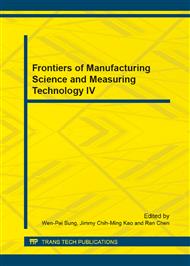[1]
Z. Kato, T.C. Pong, S.G. Qiang: Multicue MRF Image Segmentation: Combining Texture and Color Features. 16th International Conference on Pattern Recognition, Vol. 1 (2002), pp.660-663.
DOI: 10.1109/icpr.2002.1044836
Google Scholar
[2]
X. Wei, W. Shen: Image Segmentation Based on Gabor Filter and MRF Model. 5th International Conference on Wireless Communications, Networking and Mobile Computing (2009), pp.1-4.
DOI: 10.1109/wicom.2009.5301963
Google Scholar
[3]
L. Zhao, C.H. Li, F.N. Dang, D.F. Chen, S.J. Xu: Concrete CT Image Segmentation Method Based on Markov Random Field. 29th Chinese Control Conference CCC (2010), pp.2677-2680.
Google Scholar
[4]
M. Lenic, D. Zazula, B. Cigale: Segmentation of Ovarian Ultrasound Images Using Single Template Cellular Neural Networks Trained with Support Vector Machines. 20th IEEE International Symposium on Computer-Based Medical Systems (2007), pp.205-212.
DOI: 10.1109/cbms.2007.97
Google Scholar
[5]
S.H. Luo, Q.M. Hu, X.J. He, J.M. Li, J.S. Jin, M. Park: Automatic Liver Parenchyma Segmentation from Abdominal CT Images Using Support Vector Machines. ICME International Conference on Complex Medical Engineering (2009), pp.1-5.
DOI: 10.1109/iccme.2009.4906625
Google Scholar
[6]
F. Du, W.K. Shi., Y. Deng: Infrared Image Sequence Segmentation Based on Support Vector Machine. Opto-Electronic Engineering, Vol. 32, No. 3 (2005), pp.62-65, in Chinese.
Google Scholar
[7]
A. Oliver, X. Munoz, J. Batlle, L. Pacheco, J. Freixenet: Improving Clustering Algorithms for Image Segmentation Using Contour and Region Information. IEEE International Conference on Automation, Quality and Testing, Robotics (2006), pp.315-320.
DOI: 10.1109/aqtr.2006.254652
Google Scholar
[8]
S.N. Sulaiman, N.A.M. Isa: Adaptive Fuzzy-K-means Clustering Algorithm for Image Segmentation. IEEE Transactions on Consumer Electronics, Vol. 56, No. 4 (2010), pp.2661-2668.
DOI: 10.1109/tce.2010.5681154
Google Scholar
[9]
L. Grady: Random Walks for Image Segmentation. IEEE Transactions on Pattern Analysis and Machine Intelligence, Vol. 28, No. 11 (2006), pp.1768-1783.
DOI: 10.1109/tpami.2006.233
Google Scholar
[10]
L. Grady: Multilabel Random Walker Image Segmentation Using Prior Models. IEEE Computer Society Conference on Computer Vision and Pattern Recognition, Vol. 1 (2005), pp.763-770.
DOI: 10.1109/cvpr.2005.239
Google Scholar
[11]
Y.F. Yi, L.Q. Gao, L. Guo: Application of Improved FCM for Interactive Image Segmentation. Journal of Image and Graphics, Vol. 17, No. 3 (2012), pp.342-348, in Chinese.
Google Scholar
[12]
H.C. Zhao, W.N. Li, G. Pan, L.Q. Gao: An Improved Random Walker Using Spatial Feature for Image Segmentation. 25th Chinese Control and Decision Conference (2013), pp.1479-1482.
DOI: 10.1109/ccdc.2013.6561160
Google Scholar
[13]
S.G. Chen, Z.X. Sun, J. Zhou: Semi-supervised Image Segmentation Based on Integration of SSFCM with Random Walks. Journal of Computer-Aided Design & Computer Graphics, Vol. 25, No. 7 (2013), pp.1074-1082, in Chinese.
Google Scholar
[14]
T. Chaira, A. K. Ray: A New Measure Using Intuitionistic Fuzzy Set Theory and Its Application to Edge Detection. Applied Soft Computing, Vol. 8, No. 2 (2008), pp.919-927.
DOI: 10.1016/j.asoc.2007.07.004
Google Scholar


